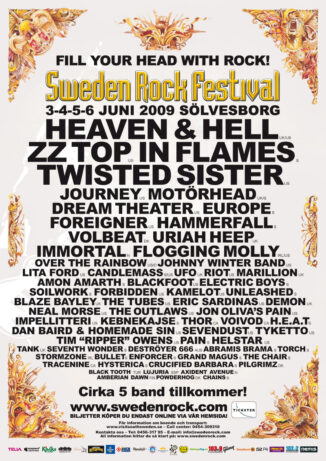
Summary
Epic Records
Release date: April 13, 2004
Guitars: A-
Bass: A
Percussion: C+
Vocals: C (only 2 songs)
Lyrics: B
Recording Quality: A
Originality: B+
Overall Rating: B+
User Review
( votes)Ever since his first album, Not of This Earth, Joe Satriani has been a master of creating an instrumental groove and letting his creative guitar wizardry serve as the vocalist for his now vast inventory of songs. There simply is no one better in the game at framing the picture and conveying the message of a song through his music and without lyrics than Satriani. Oftentimes, Satriani has accomplished the impossible when speaking musically sans lyrics; an achievement similar to a comedian bringing down the house while punching out one-liners to the audience silently via use of sign language. In his early days on that first album, Satriani “caught on” because he displayed a truly unique songwriting and guitar-speaking talent in tracks like “Hordes of Locusts” and “The Headless Horseman,” and, if anything, he has shown consistent and notable progression towards becoming a “complete” and “mature” songwriter with each subsequent release.
Is There Love In Space? represents Satriani’s ninth studio album, and definitely continues the Satriani string alive of generating solid, instrumental-dominated music that is unique, innovative, and entertaining. Satriani has always had a penchant for introducing new guitar “tricks” that no one has ever heard before into each album, and this CD definitely has its share of them, however, Is There Love In Space? is filled predominantly with simple rhythms and deliberate, slower-paced, driving chord patterns. Satriani uses a number of funk-based song foundations in this CD, containing plenty of urbane bass-end distortion, which doles out comfort food to one’s musical soul.
Satriani has seldom, if ever, allowed the percussion to take center stage in his music, and this album is no exception, however, this time around Satriani allows the bass guitar to take a more predominant role like never before in any of his previous releases. The bass guitar is played at various times by both Satriani and Matt Bissonette, and the Bowed Bass resonates at the hands of ZZ Satriani in the final track labeled “Bamboo.” Unfortunately, who plays the bass guitar as part of the other tracks (and when) is not divulged in any of the band’s promotional materials and liner notes. Regardless, though, the bass work, and especially its sound and presence, is truly outstanding. Rather than thumping or popping, the bass guitar essentially belches out power in this album, sounding similar to a drag racecar at the starting gate, utilizing every bit of engine torque available to blast out into the drag strip at the split second the green light is illuminated. It’s a unique feature to this album, and definitely one of the most memorable!
The album starts out with 3 solid rockers, highlighted by “Hands In The Air,” which is one of those songs that has a precarious tension to it contained in the opening guitar riff that says “there’s no doubt that a truly great song is on its way!” A song that comes to mind quickly that has a similar “tension” to it right out of the shoot is “Cat Scratch Fever” by Ted Nugent. Both have something special about them right from the first note letting the listener know they’re in for a true classic Metal song.
Satriani, as he has been known to dabble in from time to time, treats his listeners to 2 songs that contain lyrics. The first is the 4th track called “Lifestyle,” and is possibly his best conventional song to date. Satriani sings in a monotone voice and plays in a garage-band, 3-chord pattern to convey the message that his significant other is running way too hard and having way too much fun and will eventually crash and burn – or cause him to crash and burn first. In the end, as might be expected, he can’t find it within himself to “get out while the gettin’s good,” and keeps coming back for more time and time again. The other conventional song is “I Like the Rain,” which begins with a 1970’s psychedelic intro coupled with a revving Harley Davidson in the background, and then assumes a bobbing guitar pattern. Satriani’s voice is “tech’ed” up somewhat in this one to make him sound as if he’s being introspective and a bit distant. It works.
The other notable rocker on this album is “The Souls of Distortion,” a song filled with numerous guitar tricks, effects, and wah-wah sounds…and of course plenty of fabulous bass tones! The remaining 5 tracks, however, are all mellow by nature and reflective. None of them are wimpy by any stretch of the imagination, but they definitely are designed to create an atmosphere and elicit images in the mind of the listener. Although a couple of these tracks drag on a bit (i.e., could have been shortened to be more effective), they’re all good and certainly serve Satriani’s purpose and direction with this album. The best of these is the last track, “Bamboo,” which, as mentioned above, features Bowed Bass play by ZZ Satriani. The Bowed Bass creates a unique, almost haunting feel to this song … not haunting as in “scary,” but haunting from a “wanting” perspective, as if to encapsulate the weight carried on one’s mind upon the death of a loved one or due to the long-term departure of a friend. If nothing else, “Bamboo” indeed shows Satriani has long-since arrived as a truly mature songwriter.
This album isn’t as mind-blowing or revolutionary as say Surfing With The Alien or Engines of Creation, and it’s certainly not as aggressive as The Extremist, but it’s undeniably another solid Satriani effort that fans of instrumental Metal and music in general will enjoy. All in all, Satriani succeeds with another original musical concept, highlighted by some great bass guitar effects, a couple vocal tracks, and plenty of twists and squeezes of that third hand he calls a guitar!




Be the first to comment